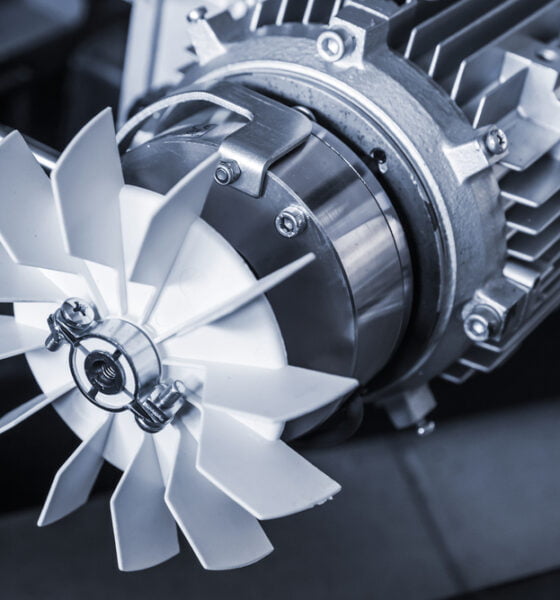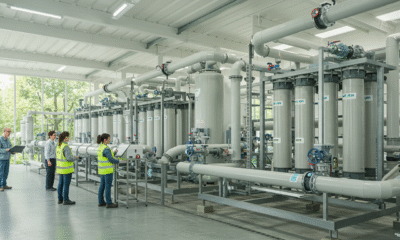

Energy
Can Soft Starters Reduce Industrial Carbon Footprints?
When you think about sustainability in business, the manufacturing sector is probably the last one to come to mind (well, after oil anyways). However, factories are one of the fastest growing types of businesses that are shifting towards sustainability. According to one analysis, the manufacturing sector accounts for 10.8% of jobs, but it employs 20.4% of green jobs.
This may be surprising to hear, but an increasing number of companies are creating green manufacturing plants to retain employees and increase job satisfaction. Going green offers monetary incentives such as tax savings, reduced costs, and increased productivity. Legal needs, rules, and regulations help reduce the carbon footprint, but there are other ways to encourage going green.
Using the right eco-friendly technology in manufacturing can lower costs by $200 to $600 billion across the industry. This statistic shows that it pays to go green. Manufacturing equipment and companies are becoming more sustainable by creating a regenerative model for their facilities. The United States Environmental Protection Agency has an overview of sustainable manufacturing.
However, many factories are still trying to figure out what to do to be eco-friendlier. They often overlook opportunities to cut their carbon footprint by reducing energy consumptoin of their machines, including their electrical motors.
One thing that eco-friendly factories may want to consider is using soft starters. Keep reading to learn what soft starters are and how they can lower the carbon footprint of the average factory.
What Are Soft Starters and How Can They Lower a Factory’s Carbon Footprint?
In industrial settings, the starting of electrical motors can be a source of significant mechanical stress and energy consumption. Therefore, they also contribute to the factory’s carbon footprint.
Soft starters are electronic devices that help to reduce the mechanical stress and energy consumption associated with the starting of electric motors. This in turn makes them eco-friendlier. Let’s explore what soft starters are, their advantages, factors to consider when choosing one, and common misconceptions about them.
An Overview of Soft Starters
An electric motor’s starting torque and current are regulated by soft starters, which are electrical devices. Instead of providing the whole voltage and frequency at once, they achieve this by gradually raising the voltage and frequency supplied to the motor over a predetermined length of time.
The motor’s lifespan is increased by the progressive rise in voltage and frequency since it causes less mechanical stress on the device. In industrial situations, such as pumps, compressors, and conveyors, where the starting of electric motors can result in severe mechanical stress, soft starters are frequently employed. Since they are more efficient, they also are better for the environment.
Also, they are utilized in cranes and conveyor belts, which both demand precise control over the beginning torque.
Types of Soft Starters
Soft starters come in a variety of forms, including:
Voltage ramp soft starters: These soft starts control the motor starting current by gradually raising the voltage that is supplied to the motor over a predetermined amount of time.
Soft starters with a current limit: These soft starters control the motor starting current by putting a cap on how much current can pass through the motor.
Soft starters with torque control: These soft starts control the voltage and frequency that are given to the motor in order to manage the starting torque of the motor.
Advantages of Soft Starters
In industrial contexts, soft starters have a number of benefits, such as:
Reduced mechanical stress – By gradually raising the voltage and frequency provided to the motor, soft starts help to minimize the mechanical stress on electric motors, extending the motor’s life.
Energy savings and lower carbon footprint – By lowering the motor starting current, soft starters contribute to a reduction in the energy used to start electric motors. Therefore, their carbon footprint is also lower.
Process control is improved thanks to soft starters, which work to precisely manage the starting torque and current of electric motors. This boosts the effectiveness of industrial operations.
Applications of Soft Starters
In a range of industrial applications, soft starters are frequently utilized.
Pumps are used to lessen the mechanical strain and energy expenditure associated with the beginning of electric motors, pumps use soft starters.
Then we have compressors. They are used to precisely control the starting torque and current of electric motors, soft starters are utilized in compressors.
Lastly, we have conveyors that are used to control the starting torque of electric motors, soft starters are used in conveyor belts. This lowers the mechanical stress on the motor and increases conveyor efficiency.
Factors to consider when choosing a soft starter
There are a number of important elements to take into account when choosing a soft starter to guarantee optimum performance and cost effectiveness while preventing potential risks. The kind of load being powered by the electric motor is a significant consideration.
For instance, if the load is a conveyor, a different soft starter may be necessary than for a motor powering a pump. While choosing the suitable kind and size of soft starter, it’s also important to consider the electric motor’s necessary starting torque.
The power source that is accessible must also be taken into account because the soft starter must function effectively within the power source’s voltage and frequency range in order to prevent any potential harm or dangers.
It’s important to note that modern soft starts come with cutting-edge technologies that can improve their functionality and safety. Specific soft starters, for instance, have built-in safeguards against voltage changes, short circuits, and other electrical dangers.
Others may have programmable logic controllers (PLCs) that can give effective control over the motor’s speed, torque, and acceleration, enabling more economic use of energy and process management.
Soft Starters Are Ideal for Factories Trying to Lower their Carbon Footprint
A growing number of factories are trying to be eco-friendlier. Soft starters are electrical components that aid in lowering the mechanical strain and energy expenditure connected with the starting of electric motors in commercial settings, which means they are great for the planet. In addition to their environmental benefits, soft starters offer a number of benefits, including less mechanical stress, energy savings, and enhanced process control.
The kind of load, necessary starting torque, and accessible power source are just a few things to keep in mind when selecting a soft starter. Soft starts are a useful tool for enhancing the effectiveness and longevity of industrial processes, despite certain widespread misunderstandings to the contrary.


 Environment10 months ago
Environment10 months agoAre Polymer Banknotes: an Eco-Friendly Trend or a Groundswell?

 Environment11 months ago
Environment11 months agoEco-Friendly Home Improvements: Top 7 Upgrades for 2025

 Features9 months ago
Features9 months agoEco-Friendly Cryptocurrencies: Sustainable Investment Choices

 Features10 months ago
Features10 months agoEco-Friendly Crypto Traders Must Find the Right Exchange





























